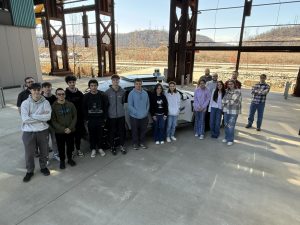Driving past Washington, Greene, and Westmoreland Counties, in the backyard of Western Pennsylvania, drilling sights and compression stations are prevalent as petroleum engineers, mechanical engineers, welders, flowback operators, and geologists collaborate about which way is the most effective way to retrieve the natural gas from the ground. The natural gas pay streak is located throughout Western Pennsylvania, into Ohio, West Virginia, and along the northern margin in central New York.
This natural gas pay streak is called Marcellus Shale. This is black shale that contains limestone beds and concentrations of iron pyrite and siderite, which is rich with natural gas. To recover this lucrative rich-in-gas shale out of the ground, a plethora of workers must be available.
Recently, Mr. Mike Forgione, geological adviser who previously worked for Range Resources and currently owns Forgione Energy LLC, visited Bethel Park High School to present an elaborate PowerPoint to the students. This PowerPoint consisted of where the gas is located, how to get it out of the ground, and all of the jobs located in Western PA because of the “big boom” and economic stability Marcellus Shale has provided.
Mr. Forgione travels all across Western Pennsylvania school districts and explains how Marcellus Shale brings thousands of jobs to the area. And the Oil & Gas industry isn’t going anywhere for a long, long time.
In addition, Mr. Forgione acknowledges that a significant part of the recovery of natural gas, which is essentially “squeezed” from the shale, are Petroleum Engineers. These engineers deal with the drilling aspect (supervising the drilling and casing and cementing of all pipe place in the well), finding the pay streaks of natural gas, and calculating more effective ways of extracting the gas. To become a Petroleum Engineer, a B.S. is required from an accredited college. Along with Petroleum Engineers, Mechanical, Chemical, Civil, and Electrical Engineers are all clumped together in the industry.
Geologists are necessary, as they determine where to drill wells based on the analysis of rocks in order to find deposits of natural gas and oil. Heavy equipment operators, construction supervisors, drillers, mechanics, and tubing unit operators are all required to execute the construction element.
The drilling process is quite involved. “First, drilling into the ground is necessary. In Allegheny County, you’re drilling down a mile, turning the bit sideways and drilling horizontal for about another mile. Then, you have to fracture the rock with water and sand,” Mr. Forgione said. “Then, the oil and gas makes its way out of the rock through the natural fractures and comes up to the surface and into the casing and into the well, and then you put it into a pipeline.”
It’s important to note that drilling down into the ground isn’t just a vertical motion. All together, it’s a smooth curve, which eventually pans out to become horizontal. “It’s a slow, sweeping motion. It’s about 10 degrees per 100 feet,” Forgione said.
Marcellus Shale has brought an array of jobs back to the area and has provided a colossal boost in the economy. The Steel Industry was brought back to life, and thousands of jobs were revived, as a variety of occupations are needed for the discovery, exploration, and recovery of natural gas, which is located in the Marcellus Shale pay streak. Throughout PA, WV, and OH all of these jobs and occupations will be around for twenty, thirty, forty, fifty years to come; with that being said, Marcellus Shale provides promising futures for young people that are intrigued by the Oil & Gas Industry.
For more information, please visit the links provided below:













